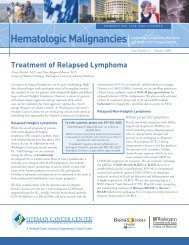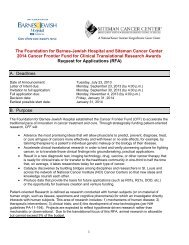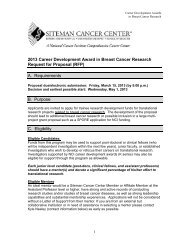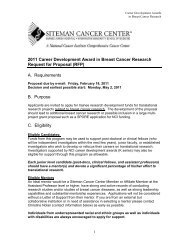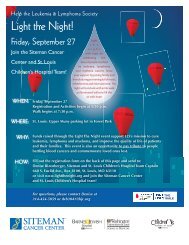Planting the Seeds of Prevention - Siteman Cancer Center
Planting the Seeds of Prevention - Siteman Cancer Center
Planting the Seeds of Prevention - Siteman Cancer Center
Create successful ePaper yourself
Turn your PDF publications into a flip-book with our unique Google optimized e-Paper software.
Highlights<br />
Jeffrey Bradley, MD, was recently installed as S. Lee Kling<br />
Endowed Chair in Radiation Oncology.<br />
Unique Radiation<br />
Treatment <strong>Center</strong><br />
Construction is under way at <strong>the</strong> <strong>Siteman</strong> <strong>Cancer</strong> <strong>Center</strong><br />
on a proton <strong>the</strong>rapy facility that could revolutionize <strong>the</strong><br />
way this unique treatment is delivered.<br />
Although proton <strong>the</strong>rapy is not new, <strong>the</strong> cost <strong>of</strong><br />
building a facility — including an immense cyclotron to<br />
generate charged particles — has been prohibitive for most<br />
cancer centers and hospitals around <strong>the</strong> country, requiring<br />
an investment <strong>of</strong> $100 million to $150 million. Only six<br />
proton <strong>the</strong>rapy facilities currently operate in <strong>the</strong> United<br />
States, with one more set to open this year.<br />
The new S. Lee Kling <strong>Center</strong> for Proton Therapy,<br />
scheduled to open in 2010, will be <strong>the</strong> first in <strong>the</strong> nation<br />
featuring a new-generation technology that costs about<br />
$20 million. <strong>Siteman</strong> is working with Still River Systems Inc.<br />
<strong>of</strong> Littleton, Mass., to build a cyclotron that fits into a space<br />
not much bigger than what’s needed to house traditional<br />
radiation <strong>the</strong>rapy equipment.<br />
“This will change <strong>the</strong> scope <strong>of</strong> facilities that use<br />
protons,” says Washington University School <strong>of</strong> Medicine<br />
radiation oncologist Jeffrey Bradley, MD, who has been<br />
named director <strong>of</strong> <strong>the</strong> Kling <strong>Center</strong>.<br />
18 The Alvin J. <strong>Siteman</strong> <strong>Cancer</strong> <strong>Center</strong><br />
Unlike traditional X-ray radiation, proton <strong>the</strong>rapy<br />
deposits its maximum dose at <strong>the</strong> site <strong>of</strong> a tumor and<br />
doesn’t go beyond that point, resulting in less damage<br />
to surrounding healthy tissue.<br />
The proton facility is named for <strong>the</strong> late S. Lee Kling, a<br />
prominent St. Louis businessman and philanthropist. His<br />
efforts helped raise $2.3 million through <strong>the</strong> Barnes-Jewish<br />
Hospital Foundation’s illumination gala to fund research<br />
into applications <strong>of</strong> proton <strong>the</strong>rapy.<br />
New Research Building<br />
Construction continues on <strong>the</strong> BJC Institute <strong>of</strong> Health<br />
at Washington University, which will serve as home base<br />
for <strong>the</strong> University’s BioMed 21 initiative. The 11-story,<br />
700,000-square-foot facility will house laboratories for<br />
research aimed at rapidly applying basic science findings<br />
to improve patient care. Among o<strong>the</strong>r occupants, <strong>the</strong><br />
institute will provide space for five interdisciplinary<br />
research centers, including one focusing on cancer<br />
genomics. BJC HealthCare contributed a $30 million<br />
gift toward <strong>the</strong> estimated $235 million cost <strong>of</strong> <strong>the</strong> project.<br />
The building is scheduled to open in December 2009.



